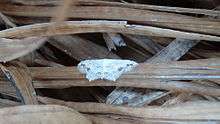Scopula pulchellata
Scopula pulchellata is a moth of the family Geometridae. It is found in the Indo-Australian tropics, from India, Sri Lanka to Taiwan and the Solomon Islands,[2] as well as in Africa.
| Scopula pulchellata | |
|---|---|
 | |
| Scientific classification | |
| Kingdom: | Animalia |
| Phylum: | Arthropoda |
| Class: | Insecta |
| Order: | Lepidoptera |
| Family: | Geometridae |
| Genus: | Scopula |
| Species: | S. pulchellata |
| Binomial name | |
| Scopula pulchellata | |
| Synonyms | |
| |
Description
Its wingspan is about 24 mm. Hindwings with more or less angled outer margin at vein 4. ochreous white colored moth. Frons fuscous. Forewings with a discocellular speck. Indistinct obliquely waved fuscous antemedial and medial lines, the latter on hindwing embracing the black discocellular spot. Both wings with waved postmedial line, with fuscous marks beyond it above middle of forewings and above inner margin of each wing. There is a sub-marginal fuscous marks series and a marginal black specks series.[3]
Subspecies
- Scopula pulchellata pulchellata
- Scopula pulchellata rufinubes (Warren, 1900)
- Scopula pulchellata semperi Prout, 1938
- Scopula pulchellata takowensis Prout, 1938
gollark: Lazy evaluation makes infinite data structures great.
gollark: I found the Prelude definition of iterate:```haskelliterate :: (a -> a) -> a -> [a]iterate f x = x : iterate f (f x)```
gollark: Huh?
gollark: If you want to define an infinitely recursive data structure, just make an infinitely recursive function.
gollark: Thanks to lazy evaluation, anything can be infinite!
References
| Wikimedia Commons has media related to Scopula pulchellata. |
| Wikispecies has information related to Scopula pulchellata |
- Sihvonen, Pasi (April 1, 2005). "Phylogeny and classification of the Scopulini moths (Lepidoptera: Geometridae, Sterrhinae)". Zoological Journal of the Linnean Society. 143 (4): 473–530. doi:10.1111/j.1096-3642.2005.00153.x.
- The Moths of Borneo
- Hampson, G. F. (1895). The Fauna of British India, Including Ceylon and Burma. Moths Volume III. Taylor and Francis – via Biodiversity Heritage Library.
This article is issued from Wikipedia. The text is licensed under Creative Commons - Attribution - Sharealike. Additional terms may apply for the media files.